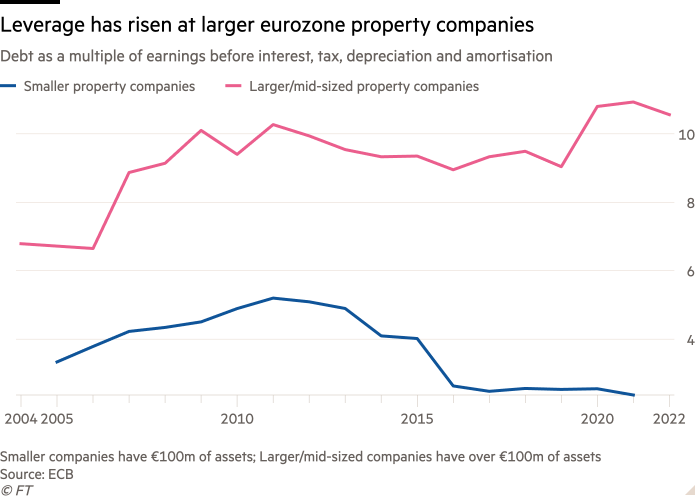Eurozone property companies are being hit by surging losses and some will struggle to support their debts, which have risen to a higher level than before the 2008 financial crisis, the European Central Bank has warned.
The losses, which the ECB said would have “consequences for the resilience of banks’ loan books”, stem from sharply higher financing costs, falling commercial property values, weaker rental income and rising concerns about the energy efficiency of buildings.
The central bank said signs of stress in the commercial property sector, which accounts for 10 per cent of all eurozone bank loans, “have the potential to significantly amplify an adverse scenario” and would “drive large losses” in the wider financial system.
The average debt of larger European property companies has risen above 10 times their earnings, “close to or above pre-global financial crisis levels”, the ECB said in part of its twice-yearly financial stability review. The full review is out on Wednesday, but the ECB published its concerns on commercial real estate a day early.
Rises in ECB interest rates have hit the sector hard. It now costs 2.6 percentage points more to finance the purchase of commercial real estate assets in Europe than it did before rates started increasing last year, according to eurozone credit registry data. The central bank’s benchmark deposit rate is now 4 per cent — up from minus 0.5 per cent before the tightening cycle began.

The rise in borrowing costs would pose a refinancing challenge for the most indebted companies, the ECB said, pointing out that rating agency Moody’s Analytics had cut ratings or outlooks on 40 per cent of European real estate companies in the year to March 2023.
The problem is most acute in countries such as Finland, Ireland, Greece and the Baltic states, where more than 90 per cent of loans to commercial property companies are at variable rates or mature in the next two years. This compares with only 30 per cent in the Netherlands and 40 per cent in Germany.
“Business models established on the basis of pre-pandemic profitability and low-for-long interest rates may become unviable over the medium term,” the ECB warned.
The sharp downturn in eurozone commercial real estate is underlined by the 47 per cent drop in the number of transactions in the sector in the first half of this year, compared with the same period in 2022.

The share of bank loans to lossmaking real estate borrowers is expected to double to 26 per cent, the ECB said. But it warned this could rise to half of all loans if turnover in the sector fell by a fifth and the tighter financing conditions persisted for another two years.
The central bank said debt levels were likely to “deteriorate further as these firms’ earnings decline and commercial real estate prices are revalued downwards”.
Shifts to homeworking and online retail have hit demand for offices and shops, weighing on rental income for property owners, while older and lower-quality buildings are suffering bigger drops in rents as tenants focus more on a building’s energy efficiency.
In a sign of how investors believe the price of commercial property has fallen sharply in the past two years, the market value of listed eurozone property companies has fallen from 110 per cent of the book value of their assets to less than 70 per cent.
Europe’s residential property sector has faced similar challenges. But the ECB said a strong labour market was helping to keep mortgage defaults low, while housing shortages and rising construction costs were providing support to prices.

